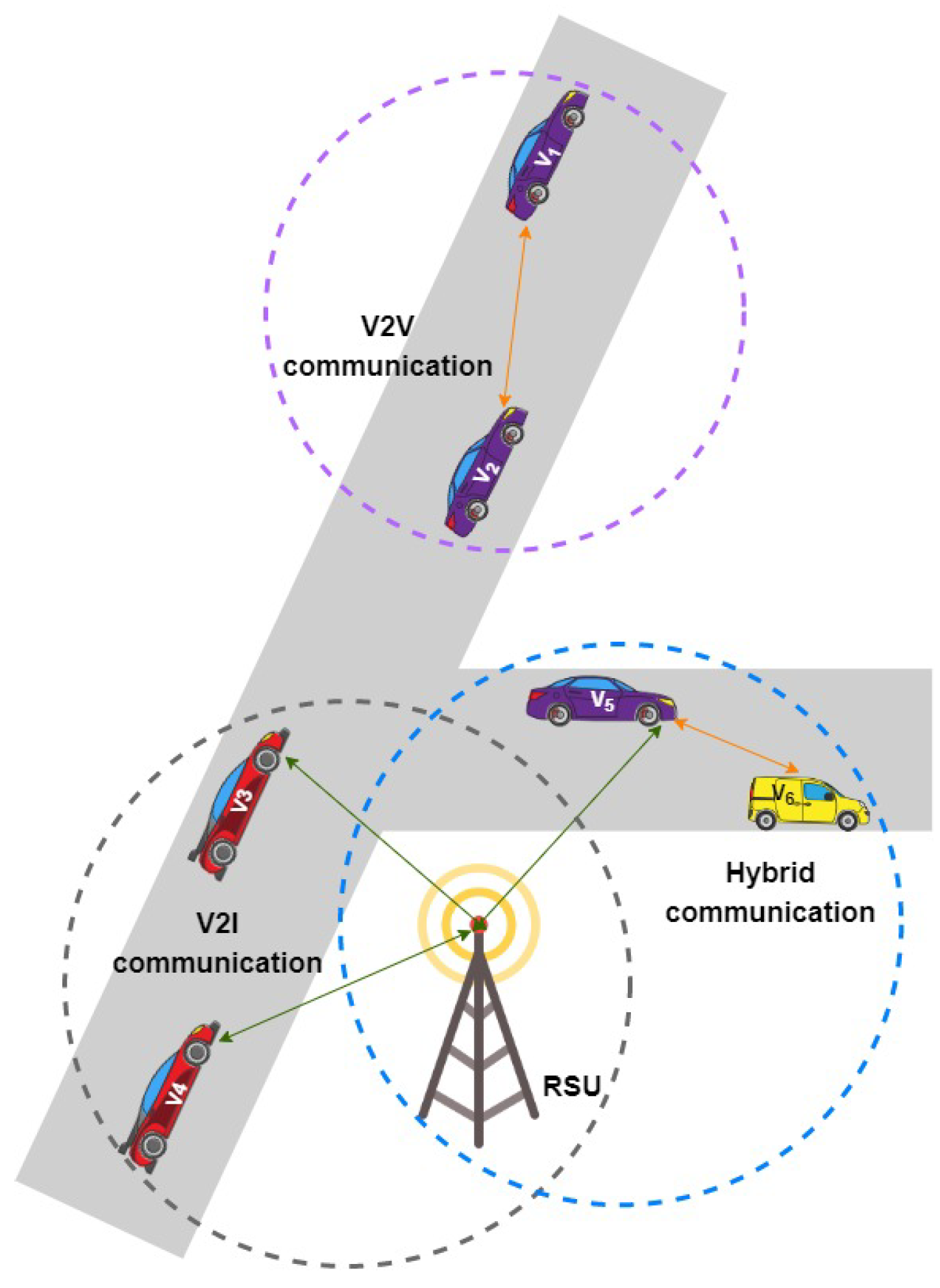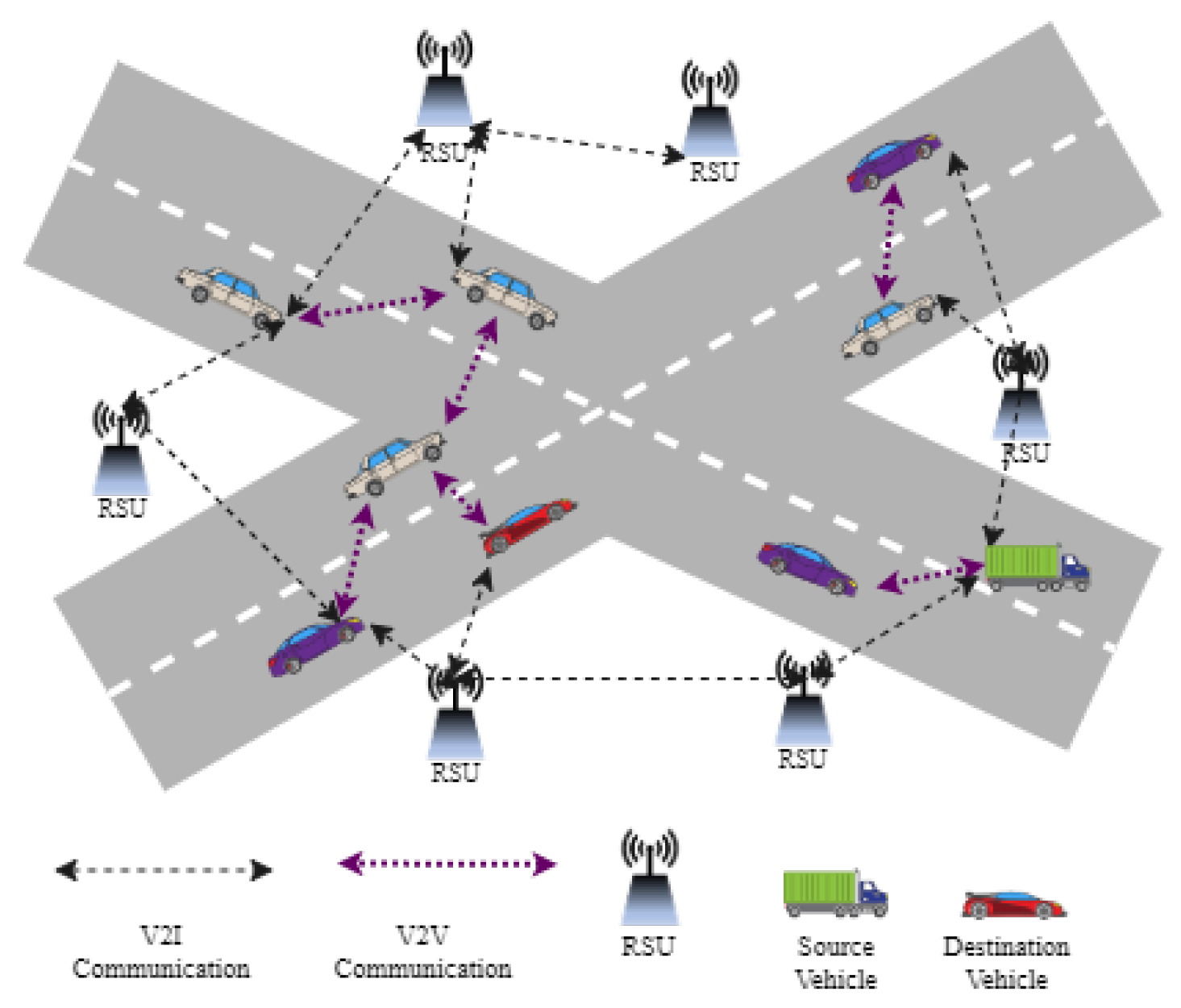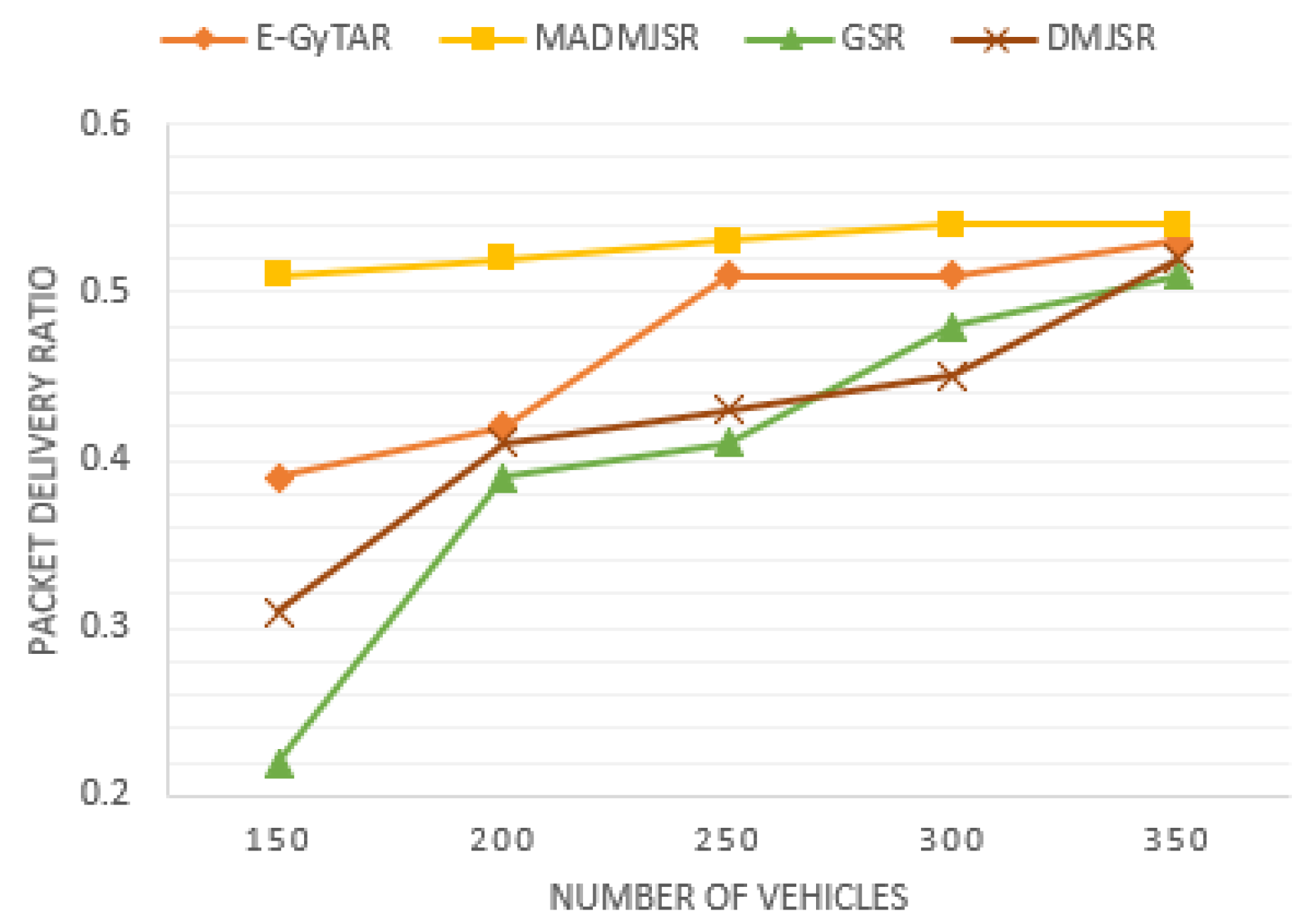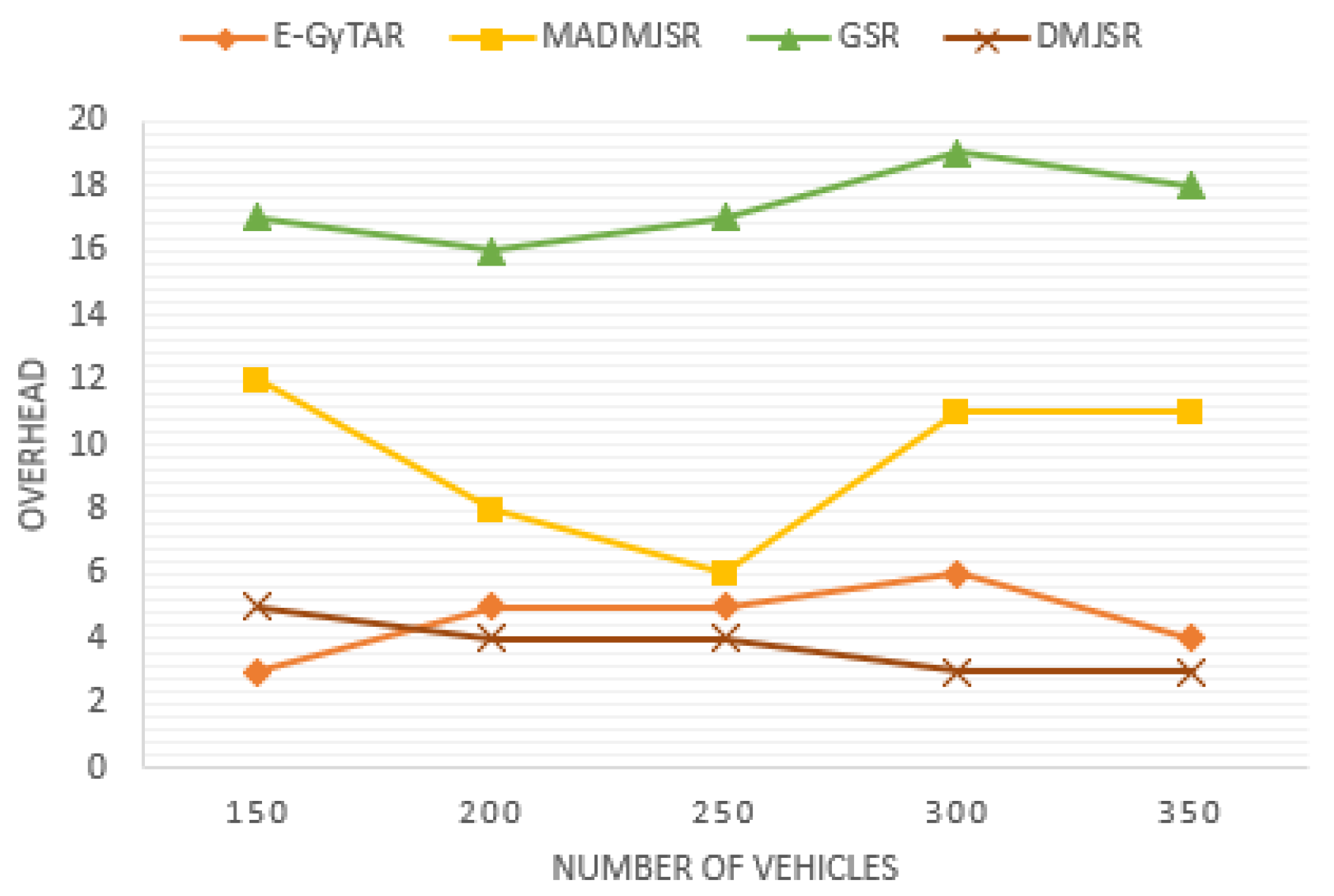1. Introduction
Vehicular ad hoc networks (VANETs) enables vehicles to communicate with one another to improve the road-safety environment. The self-organized VANETs enable vehicle-to-vehicle (V2V) and vehicle-to-infrastructure (V2I) communication [
1] to obtain traffic data such as emergency road information, vehicle location and speed, and traffic congestion information, as shown in
Figure 1. Vehicles exchange their speed and location information in V2V communication, while V2I communication enables vehicles to share their information with radars, sensors, cameras, lane makers, streetlights, and parking meters information with other vehicles. The V2V communication in VANETs is self-organized and supports various safety/non-safety applications to facilitate the drivers.
High-speed vehicles change topology frequently [
1,
2,
3], which results in frequent disconnections and sporadic connectivity. The mobility pattern, road topology, and impediments all need to be taken into account for successful message transmission. Various routing protocols have been proposed to overcome the disruptive communication links limitation in VANETs [
3], but there is still room for improvement, especially in routing schemes. The aforementioned issues in VANETs encourage researchers to propose an optimal solution to increase the efficiency of the network. The 3GPP standard has proposed two categories for VANETs in its release. The first category includes topology-dependent routing, and the second category includes vehicle location-based routing. The location-based routing further includes junction-based protocols for an urban scenario [
3].
The junction selection protocols are divided into two phases. The junction phase includes the packet transmission between junctions, and the second phase includes data transmitted between road segments. The source vehicle searches the destination vehicle junction to transmit the packet successfully as shown in
Figure 2.
1.1. Previous Work
In this subsection, we have summarized the relevant research contributions in junction selection in VANETs. Diverse road-matrices-based junction selection and forwarder vehicle selection protocols have been proposed to improve communication efficiency. The author in [
1] proposed the geographic source routing (GSR) routing protocol to consider the location of the vehicle at the junction and proposed a greedy routing protocol for packet transmission. The location-based greedy routing may lead the packet away from the destination. The greedy perimeter coordinator routing (GPCR) is proposed to enable greedy routing in the urban scenario [
4]. The nearest neighbor vehicle is selected as the best forwarder to share packets between junctions. Moreover, an improved traffic-aware greedy scheme similar to GyTAR [
5] is proposed to consider direction metrics to select the most optimal junction for communication.
The traffic flow-oriented routing protocol (TFOR) suggests selecting the junction based on the traffic direction and handover of the packet to a two-hop neighbor vehicle [
6]. The directional geographic source routing (DGSR) [
7] and dynamic multiple junction selection-based routing (DMJSR) scheme suggested directional packet forwarding and closest junction selection strategy to overcome communication delays [
8].
Most of the literature considers single-road metrics such as the number of vehicles on the road or the distance with static predefined weight values to improve the accuracy of the system. However, these matrices’ junction selection decreases the communication efficiency and often leads to inappropriate junction selection. To overcome this, there is a strong need to propose a multi-metric junction-selection technique that is not only efficient but also improves the accuracy of the system.
The author has proposed the multi-hop intersection-based routing protocol for VANETs [
9]. It overcomes the limitation of candidate junction selection based on traffic density. However, considering one parameter does not provide the optimal solution for packet forwarding in VANETs. It does not specify the disruptive communication link issue. Moreover, in [
10] the author proposed the geographic-aware routing protocol for multi-hop packet forwarding in VANETs. It also overcomes the limitation of disruptive communication links. However, few research contributions emphasize trust-based routing protocols for reliable communication. However, the packet forwarding to an optimal junction is still a challenge [
11]. The authors in [
8] proposed the position-based routing protocol for VANETs to overcome the limitation of frequent change in topology. Moreover, it also overcomes disruptive communication links using DMJSR. The study shows promising improvement in network efficiency. The navigation system has improved by considering data mining in VANETs. The author in [
12] provides a comprehensive analysis of different artificial intelligence (AI) techniques in VANETs to improve network connectivity. The traffic density-based routing protocol in VANETs has been proposed in [
13]. The high-density traffic has been considered to forward the packet between junctions to overcome the limitation of latency. The author in [
14] proposed the computational intelligence method to provide smart connectivity in IoT. The study shows promising improvements in QoS requirements in a highly connected environment.
Considering the above-mentioned limitations in position-based routing, we proposed the optimal weighted multiple attribute junction selection protocol using an intelligent “Multi-Attribute Decision-Making” technique for the junction selection.
The novel proposed protocol utilizes three metrics: distance, traffic density, and angle selection, to improve the accuracy of the system. The optimal weight estimation and assignment techniques are used for updating the metrics. The proposed scheme is simulated in Network Simulator 2 (NS2), and the results are compared with E-GyTAR, GSR, and DMJSR. The comparative results analysis shows promising improvement in the network performance, which is discussed in the upcoming sections. The novelties of the proposed scheme are summarized as follows:
The distance between the current junction and destination, the traffic density on each candidate road segment, and the angle between the source junction and candidate junction are considered as the most optimal junction selection parameters.
The intelligent junction selection method “Multi-Attribute Decision Making (MADM)” is employed to improve the accuracy of the scheme.
The optimal weight value for each parameter is re-determined in the scheme.
The intelligent junction selection method “Multi-Attribute Decision Making (MADM)” is employed to improve the accuracy of the scheme that is explained below.
1.2. Multi-Attribute Decision Making (MADM)
MADM junction selection routing (MADMJSR) is modeled as the MADM approach as it considers multiple attributes for junction selection. MADM has various approaches, but the “Technique for Order Preference by Similarity to an Ideal Solution (TOPSIS)” is applied in MADMJSR. TOPSIS is less complex than other techniques and has minimum network overhead. It estimates optimal solutions from multiple attributes. The property to separate the ideal solution from the concrete solution increases the accuracy of the scheme.
The research paper is further divided into three sections.
Section 2 discusses the system model. It also covers the proposed algorithms and the formulation of the solution in detail. In
Section 3, the simulated environment and performance evaluation matrices are discussed, followed by a comparative analysis between the previously proposed scheme and our optimal junction selection protocol. In the end, research contributions are concluded in
Section 4.
2. System Model
For the proposed model, the MADAM-based junction selection algorithm and mathematical model are used [
15]. It considers the distance, traffic density, and angle between the candidate junction to the destination junction in the path selection process [
16]. Note that the distance is the geographical distance from the candidate junction to the destination junction [
17], the traffic density is defined as the number of vehicles on the road segment, and the angle is defined as the angle between the current junction and the candidate junction towards the destination junction [
16]. The main goal of the proposed protocol is to guarantee that the routing path has more connectivity within city environments, which ensures an increase in the packet delivery ratio and a significant decrease in the end-to-end delay. The early version of the manuscript with the title “Intelligent junction selection considering multiple attributes in position-based VANET routing” is submitted to IET Technical Review. The proposed technique considered the static weights for distance and speed [
18]. The assumptions of the proposed protocol are
Every vehicle is supported with a GPS device to obtain its position.
The sending node is aware of the current location of the destination node via the hierarchical location system (HLS).
Each vehicle knows its direction and velocity.
Every vehicle knows the traffic density between two junctions by using a traffic sensor.
The optimal junction selection process is explained below:
In Equation (1);
represents all of the candidate junctions, and
represent the distance, traffic density, and angle, respectively.
is the original data of distance, traffic density, and angle that the forwarding vehicle obtains from each candidate junction.
, whereas N represents the junction number. The decision matrix is shown below in Equation (1):
Let
and
denote the maximum and minimum values in matrix D, respectively. x represents the attributes
or
in matrix D, whereas i represents a row and j represents a column in matrix D. This computation is done using the following equation. Here,
represents the normalized value of Equations (2) and (3).
Then, the normalized matrix
of Equation (4) is calculated as below; the
are the normalized attribute value:
, , are optimized weight values for each attribute in matrix Z, as shown in Equation (5). We obtain this optimal weight value from the simulation. In the original TOPSIS, users can determine the optimal weight value for each parameter. If an on-road user is not available to allocate weight to the selected parameters, then the default weights value is applied. This means that the forwarding vehicle has to determine the weight value whenever it selects the next junction. Otherwise, the default value is applied.
However, the default weight may have a certain impact on the accuracy. So, it is worth paying attention to the weight value assignment for each parameter. The most effective weight can be obtained from the infinite simulations. We simulated a variety of weight values in a variety of scenarios. Through repetitive simulations, we found out that 0.2, 0.7, 0.1 for distance, traffic density, and angle are the most optimal weight values.
Therefore, instead of the default weight in TOPSIS, this optimal weight value will be used in TOPSIS for junction selection. We also show the efficiency of this weight in the simulation section.
Figure 3 shows the negative and positive situations to selecting the junction.
represents the worse junction selection value, whereas
represent the optimal junction selection value for packet forwarding. The following Equations (6) and (7) are used to calculate the ideal solution. While
shows the membership of candidate junction with all provided junctions J.
The distance between a positive situation and a negative situation helps in finding the rank of every available junction. and represent the distance between optimal and worse junction selection values from each parameter. represents the attribute in normalized matrix Z, as shown in the following Equations (8) and (9).
represents the normalized values of optimal attributes, whereas
represents the normalized values of worse attributes.
The principle of Equations (8) and (9) is clearly shown in
Figure 3.
RAD is very helpful in finding the ideal situation for junction selection. The calculation process of the rank result of available junctions is explained in follow equation. R is used to rank the result of each junction as shown in Equation (10).
, a set of alternatives, can now be preference-ranked according to the descending order of
. By arranging all of the ranked results, we can obtain the best junction. The process of junction selection based on TOPSIS is described in Algorithm 1.
| Algorithm 1 Junction Selection-based TOPSIS |
- 1:
Input: Three Parameters (Distance, Traffic Density, Angle) of each Junction. - 2:
Output: The Optimal Candidate Junction. - 3:
whiledo - 4:
Create a Decision Matrix D - 5:
for do - 6:
- 7:
end for - 8:
- 9:
if then - 10:
- 11:
else - 12:
if then - 13:
- 14:
end if - 15:
end if - 16:
for do - 17:
- 18:
- 19:
end for - 20:
for each do - 21:
- 22:
end for ▹ Rank the solutions and return the solution with maximum - 23:
end while
|
After junction selection, greedy forwarding is used in road segment mode. The source vehicle transmits the packet to the next vehicle, which is closest to the destination in its communication range [
19].
If there is no node closest to the destination than the forwarding node itself, then the forwarding node will store the data packet till finding a neighbor or reaching the next junction [
16].
3. Simulation Results
The proposed protocol is simulated in NS-2 simulation software. The detail of simulation parameters is summarized in
Table 1.
In our city-simulation scenario, vehicles are distributed randomly on the two directions road segment. The vehicle mobility pattern is generated by using VanetMobiSim, and the map size is 2500 × 2000 m
. The simulation scenario is shown in
Figure 4. There are also different numbers of junctions that have been considered. We have compared MADMJSR simulated results with previously proposed junction selection schemes GSR, E-GyTAR, and DMJSR. We compared the simulation result in terms of packet delivery ratio, end-to-end delay, and routing overhead. Packet delivery rate is defined as the percentage of packets that are successfully delivered to their destination vehicles. End-to-end delay is defined as the average delay incurred by the packet from its source to its destination. Routing overhead is the ratio of total control packets produced to the total data packets received at the destinations during the complete simulation.
Figure 5 shows that the proposed protocol packet delivery ratio increases with an increasing number of vehicles compared to other schemes as MADMJSR utilizes optimal weight values for junction selection rather than static values. Moreover, it selects the road segment with the shortest distance and highest traffic density for packet forwarding. Consequently, a packet will be transmitted in the high-traffic density city area on the street to ensure high network connectivity. Many vehicles on the road segment can increment a high packet delivery ratio.
Figure 6 illustrates that MADMJSR outperforms E-GyTAR, GSR, and DMJSR in terms of end-to-end delay as well. In MADMJSR, the highest traffic density, the shortest distance, and the mini-angle for junction selection are used. The existing protocols only consider traffic density or distance but do not consider the direction of the vehicle mobility, which can lead the packet away from the destination. This increases the end-to-end delay in packet sharing.
Figure 7 shows the routing overhead of all three protocols with respect to the number of nodes. With an increase in the number of nodes, there is an increase in the routing overhead for all of the protocols. The proposed scheme has a higher routing overhead when compared with existing protocols. This is because, in the proposed scheme, three parameters are considered. Obtaining this information uses more network overhead than others. In addition, the proposed scheme has to rank the calculation result; it also takes some network overhead. However, other protocols do not undertake this process.

















